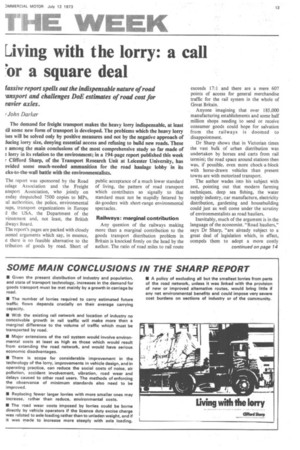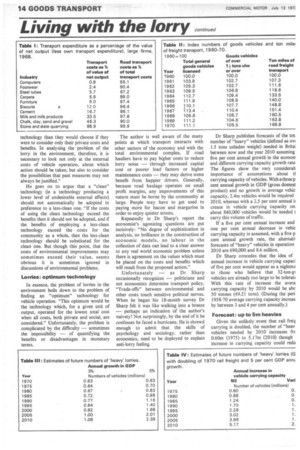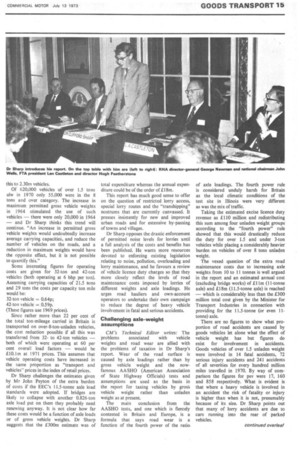Living with the lorry: a call or a square deal
Page 15

Page 16

Page 17

Page 18

If you've noticed an error in this article please click here to report it so we can fix it.
fassive report spells out the indispensable nature of road .ansport and challenges DoE estimates of road cost for eavier axles.
John Darker The demand for freight transport makes the heavy lorry indispensable, at least itil some new form of transport is developed. The problems which the heavy lorry ises win be solved only by positive measures and not by the negative approach of ducing lorry size, denying essential access and refining to build new roads. These e among the main conclusions of the most comprehensive study so far made of e lorry in its relation to the environment; in a 194-page report published this week r Clifford Sharp, of the Transport Research Unit at Leicester University, has ovided some much-needed ammunition for the road haulage lobby in its cks-to-the-wall battle with the environmentalists.
The report was sponsored by the Road tulage Association and the Freight ansport Association, who jointly on esday despatched 7500 copies to MPs, :al authorities, the police, environmental )ups, transport organizations in Europe d the USA, the Department of the vironment and, not least, the British iilways Board.
The report's pages are packed with closely isoned arguments which say, in essence, it there is no feasible alternative to the tribution of goods by road. Short of public acceptance of a much lower standard of living, the pattern of road transport which contributes so signally to that standard must not be stupidly fettered by do-gooders with short-range environmental spectacles.
Railways: marginal contribution
Any question of the railways making more than a marginal contribution to the goods transport distribution problem in Britain is knocked firmly on the head by the author. The ratio of road miles to rail route exceeds 17:1 and there are a mere 607 points of access for general merchandise traffic for the rail system in the whole of Great Britain.
Anyone imagining that over 185,000 manufacturing establishments and some half million shops needing to send or receive consumer goods could hope for salvation from the railways is doomed to disappointment.
Dr Sharp shows that in Victorian times the vast bulk of urban distribution was undertaken by horses and carts from rail termini; the road space around stations then was, if possible, even more chock-a-block with horse-drawn vehicles than present towns are with motorized transport.
The author wades into his subject with zest, pointing out that modern farming techniques, deep sea fishing, the water supply industry, car manufacture, electricity distribution, gardening and housebuilding could just as well come under the scrutiny of environmentalists as road hauliers.
Inevitably, much of the argument is in the language of the economist. "Road hauliers," says Dr Sharp, "are already subject to a great deal of legislation which, in effect, compels them to adopt a more costly technology than they would choose if they were to consider only their private costs and benefits. In analysing the problem of the lorry in the environment, therefore, it is necessary to look not only at the external costs of vehicle operation, about which action should be taken, but also to consider the possibilities that past measures may not always be justified."
He goes on to argue that a "clean" technology (ie a technology producing a lower level of undesirable external effects) should not automatically be adopted in preference to a less-clean one. "If the costs of using the clean technology exceed the benefits then it should not be adopted, and if the benefits of employing a less-clean technology exceed the costs for the community as a whole, then the less-clean technology should be substituted for the clean one. But though this point, that the costs of environmental improvements may sometimes exceed their value, seems obvious it is sometimes ignored in discussions of environmental problems.
Lorries: optimum technology In essence, the problem of lorries in the environment boils down to the problem of finding an "optimum" technology for vehicle operation. "This optimum would be the technology which, for a given unit of output, operated for the lowest total cost when all costs, both private and social, are considered." Unfortunately, the problem is complicated by the difficulty sometimes the impossibility of quantifying the benefits or disadvantages in monetary terms. The author is well aware of the many points at which transport interacts with other sectors of the economy and with the total environmental complex. If road hauliers have to pay higher costs to reduce lorry noise through increased capital cost or poorer load factors or higher maintenance costs they may derive some benefit from happier drivers. Generally, because road haulage operates on small profit margins, any improvements of this nature must be borne by the community at large. People may have to get used to paying more for bacon and margarine in order to enjoy quieter streets.
Repeatedly in Dr Sharp's report the economist's agonizing questions are put incisively: "No degree of sophistication in analysis, no brilliance in the construction of economic models, no labour in the collection of data can lead to a clear answer to any real world economic problem unless there is agreement on the values which must be placed on the costs and benefits which will result from the proposed action."
Unfortunately as Dr Sharp occasionally recognizes politicians and not economists determine transport policy. "Trade-offs" between environmental and other costs touch sensitive political nerves. When he began his 18-month survey Dr Sharp felt it was like walking into a breeze perhaps an indication of the author's naivety! Not surprisingly, by the end of it he confesses he faced a hurricane. He is shrewd enough to admit that the skills of psychology and sociology, rather than economics, need to be deployed to explain anti-lorry feeling.
Dr Sharp publishes forecasts of the tot number of "heavy" vehicles (defined as ovl 1.5 tons unladen weight) needed in Brit& between now and the year 2010 assuming five per cent annual growth in the econom and different carrying capacity growth rate The figures show the very considerab importance of assumptions about ti carrying capacity of vehicles. With athreep cent annual growth in GDP (gross domest product) and no growth in average vehic capacity, 2.4m vehicles would be required 2010, whereas with a 2.5 per cent annual ii crease in vehicle carrying capacity on about 840,000 vehicles would be needed t carry this volume of traffic.
If a five per cent annual increase and one per cent annual decrease in vehic carrying capacity is assumed, with a five p cent annual growth rate, the alternati, forecasts of "heavy" vehicles in operation 2010 are 690,000 and 8.6 million.
Dr Sharp concedes that the idea of annual increase in vehicle carrying capac of five per cent would appear as a nightmf to those who believe that 32-ton-gi vehicles are already too large to be tolerat( With this rate of increase the avera carrying capacity by 2010 would be abc 50 tonnes (49.21 tons). (During the pen 1958-70 average carrying capacity increas by between 3 and 4 per cent annually.) Forecast: up to 5m heavies Given the unlikely event that rail freil carrying is doubled, the number of "heav vehicles needed by 2010 increases frc 0.60m (1975) to 5.17m (2010) though increase in carrying capacity could redu this to 2.30m vehicles.
Of 620,000 vehicles of over 1.5 tons ulw in 1970 only 55,000 were in the 8 tons and over category. The increase in maximum permitted gross vehicle weights in 1964 stimulated the use of such vehicles — there were only 20,000 in 1964 — and Dr Sharp thinks this trend will continue. "An increase in permitted gross vehicle weights would undoubtedly increase average carrying capacitie, and reduce the number of vehicles on the roads, and a reduction in maximum weights would have the opposite effect, but it is not possible to quantify this."
Some interesting figures for operating costs are given for 32-ton and 42-ton vehicles (both operating at 6 bhp per ton). Assuming carrying capacities of 21.5 tons and 29 tons the costs per capacity ton mile would be: 32-ton vehicle = 0.64p ; 42-ton vehicle = 0.59p.
(These figures use 1969 prices).
Since rather more than 22 per cent of the total ton-mileage carried in Britain is transported on over-8-ton-unladen vehicles, the cost reduction possible if all this was transferred from 32to 42-ton vehicles — both of which were operating at 60 per cent overall load factors — would be £10.1m at 1971 prices. This assumes that vehicle operating costs have increased in the same proportion as "transport and vehicles" prices in the index of retail prices.
Dr Sharp challenges the estimates given by Mr John Peyton of the extra burden of Costs if the EEC's 11.5-tonne axle load standards were adopted. If bridges are likely to collapse with another 0.826-ton axle load put on them they probably need renewing anyway. It is not clear how far these costs would be a function of axle loads or of gross vehicle weights. Dr Sharp suggests that the £300m estimate was of total expenditure whereas the annual expenditure could be of the order of £18m.
This report has much good sense to offer on the question of restricted lorry access, special lorry routes and the "transhipping" nostrums that are currently canvassed. It presses insistently for new and improved urban roads and for extensive by-passing of towns and villages.
Dr Sharp opposes the drastic enforcement of permitted noise levels for lorries until a full analysis of the costs and benefits has been published. He wants more resources devoted to enforcing existing legislation relating to noise, pollution, overloading and lorry maintenance, and he favours a review of vehicle licence duty charges so that they more closely reflect the levels of road maintenance costs imposed by lorries of different weights and axle loadings. He urges road hauliers and own-account operators to undertake their own campaign to reduce the degree of heavy vehicle involvement in fatal and serious accidents.
Challenging axle-weight assumptions CM's Technical Editor writes: The
problems associated with vehicle weights and road wear are allied with the problems of taxation in Dr Sharp's report. Wear of the road surface is caused by axle loadings rather than by gross vehicle weight and the nowfamous AASHO (American Association of State Highway Officials) tests and assumptions are used as the basis in the report for taxing vehicles by gros's vehicle weight rather than unladen weight as at present.
The main conclusion from the AASHO tests, and one which is fiercely contested in Britain and Europe, is a formula that says road wear is a function of the fourth power of the ratio. of axle loadings. The fourth power rule is considered unduly harsh for Britain as the local climatic conditions of the test site in Illinois were very different as was the mix of traffic.
Taking the estimated excise licence duty revenue as £110 million and redistributing this sum among four unladen weight groups according to the "fourth power" rule showed that this would drastically reduce the duty for over 1.5 and under 3-ton vehicles while placing a considerably heavier burden on vehicles of over 8 tons unladen weight.
The vexed question of the extra road maintenance costs due to increasing axle weights from JO to 11 tonnes is well argued in the report and an estimated annual cost (excluding bridge works) of Ellin (11-tonne axle) and £18m (11.5-tonne axle) is reached — which is considerably less than the £300 million total cost given by the Minister for Transport Industries in connection with providing for the 11.5-tonne (or even 11tonne) axle.
There are no figures to show what proportion of road accidents are caused by goods vehicles let alone what the effect of vehicle weight has but figures do exist for involvement in accidents. Goods vehicles of over 1.5 unladen weight were involved in 14 fatal accidents, 72 serious injury accidents and 241 accidents of all severities for every hundred million miles travelled in 1970. By way of comparison the figures for psv were 17, 160 and 858 respectively. What is evident is that where a heavy vehicle is involved in an accident the risk of fatality or injury is higher than when it is not, presumably because of its size. Dr Sharp points out that many of lorry accidents are due to cars running into the rear of parked vehicles.
It is generally agreed that the 38 or 40ton gcw trucks envisaged under EEC legislation will have equivalent or better braking performance to the existing 32 tonnes and therefore the accident risk to other vehicle users or pedestrians should be no higher. In fact bigger lorries could carry more goods and theoretically at least it is argued there would be fewer of them to cause or be involved in accidents.
Dr Sharp's report tackles the problem of noise in the same level-headed way as the other main topics pointing out that understanding of noise measurement is "by no means easy for those who have not made a study of it". Added to the purely analytical problems of noise are the intangibles of various people's reaction to it. Dr Sharp says on this point: "The reaction to traffic noise is a psychological phenomenon and the degree of unpleasantness will differ with different people, and for the same people in different conditions."
Tests carried out at MIRA in 1960 lead to the conclusion that 80 dB(A) was the dividing line between "acceptable" and "noisy" but Dr Sharp points out that people may be conditioned to accept higher or lower noise levels and even that reaction to traffic noise may vary with social class. Interviews with the vehicle manufacturers showed that a lowering of the existing noise levels (effectively 92 dB(A) for vehicles over 3.5 ton gvw) was possible but expensive.
Noise barriers: a better bet?
As is well known, a programme aimed at reducing heavy vehicle noise to 80 dB(A) is under way at the TRRL but nobody is willing to say what achieving such a level would cost. Typical comments were that it would be a "multi-million pound exercise" or that it would involve "a huge rise in costs". In some instances such as trunk roads and motorways it is suggested that the money to achieve a quieter truck might be better spent on noise barriers which have been proved to reduce noise nuisance appreciably.
The main strength of Dr Sharp's work is that he is not blinkered in his approach, and suggests many "non-standard" possibilities. It has been proved, for example, that noise does not rise linearly with traffic flow and therefore it is suggested that the community as a whole would benefit if traffic was concentrated into fewer main routes. The general noise level of the main road would not increase in proportion to the lowering in noise level felt over a much wider area. In the same way Dr Sharp points out that the lorry is not responsible for all traffic noise and even if lorries were removed completely the general noise level would remain high.
As regards pollution the lorry, and the diesel engine in particular, is shown to be a less important and less difficult problem than that of noise. Compared with the petrol engine the diesel engine has a very clean exhaust; existing engines can meet the current Californian maximum emission levels and the stiffer 1975 could be reached although they would create more of a problem mainly in the reducing of NOx emissions.
The current BS AU 141a: 1971 requirement for exhaust smoke levels, says Dr Sharp, should be sufficiently strong to satisfy environmental interests, though there must always be a problem of enforcement. "Black smoke emission, although it may not be harmful to health, is very unpleasant and operators should make every possible effort to prevent its occurrence.
Introducing his report at a press conference on Tuesday, Dr Sharp pointed' Out that while there was a legal restriction on the emission of diesel exhaust smoke — which was objectionable rather than toxic — there was no law to limit the poisonous emissions from petrol engines.
Taxation: the ideal method
Questioned on the ideal method of taxing heavy vehicles, Dr Sharp favoured a tax based on gross weight to cover the estimated road wear, leaving any other taxation to be in the form of fuel duty. Asked about hauliers' reactions to the idea of a gross weight tax system, the RHA national chairman. Mr John Wells, said the Association had considered this, but some members had objected on the grounds that some low-mileage vehicles would be unfairly penalized simply because they were heavy vehicles. Bigger vehicles had kept haulage costs down and switching a higher proportion of tax to the heavies — as had been suggested — would negate this. The director of the FTA, Mr Hugh Featherstone, thought that the EEC proposals for road-wear tax would not necessarily result in a significantly higher tax for the heavier, vehicles than applied now.
Dr Sharp, answering a questioner, thought that 40 metric tons gross weight might be the best heavy vehicle figure from a combined economic and environmental point of view. Mr Wells and the VIA president, Mr Len Castleton, both supported the general idea of heavier vehicles; Mr Wells said British industry was at a disadvantage compared with the Continent because of Britain's 32-ton limit and Mr Castleton thought that 32-tonners would not necessarily be replaced by the same number of 40-tonners.
The report Living with the lorry can be obtainec price £3.00 (or a shorter version for 50p from the Freight Transport Association Sunley House, Bedford Park, Croydon CR 1XU or the Road Haulage Association, 2'i Upper Woburn Place, London WC1 OES.
































































































